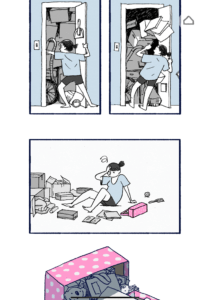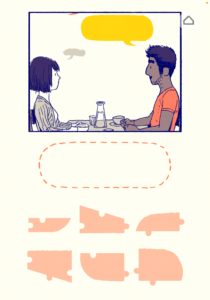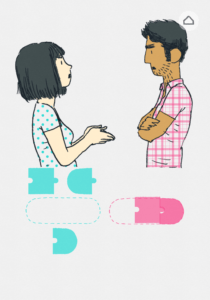Introduction
Florence is an interactive story game developed by Mountains and designed by Ken Wong, the same designer as Monument Valley. This game is intended for everyone who enjoy interactive stories or new gamers who are not familiar with video games. However, I’d say it’s more targeted towards female-identified players as they would resonate more with the protagonist of the game. While Florence is available on platforms included Steam, Mac, Windows, iOS/Android, I ended up playing it on my iPad.
Central Argument
Playing like a feminist means being able to build empathy for Florence–the protagonist of the game–through the mechanisms of interacting with objects in the game. The interactivity intertwines with the feminist theories by providing a sense of agency to the players, giving them the opportunity to reflect and act in and outside of the feminist narrative. The game perfectly captures the essence of a feminist video game with its unique art style, calming music, and novel mechanism.
Analysis
The moment the player enters the game, they immediately begin the feminist narrative of the protagonist Florence Yeoh, a 25-year-old woman living alone. The narrative is separated into different acts and chapters, each representing different stages of Florence’s life. Players will follow through her life by interacting with objects, resembling living her life via various actions and decisions, thus building a sense of connection and empathy with Florence. Since the narrative only progresses when players complete certain actions, the game provides a sense of agency to the players. Even though the story is linear, they feel the illusion that they have control over the game. This sense of agency has the power to extend beyond the game. For instance, after Florence breaks up with Krish, players has the agency to help Florence reconstruct her life by restoring her painting interests and living a better life without Krish. The development of this narrative reminds the players that they have the agency to reconstruct their life outside of the game, propelling them to pursue their ideal life direction after the game. The narrative also encourages moments of reflection by having players interact with the clock and view Florence’s past memory, forcing players to recall their own memories or passions that they have forgotten.

Unlike other traditionally masculine perspectives, the non climax-centric nature of the narrative also highlights the feminist narrative of the game. The game guides users through Florence’s day to day life from various perspectives, including brushing teeth, eating, calling family members, working, getting into relationship, breaking up, and reconstructing life after break up.


When I was playing the game, I felt my emotion fluctuates whenever Florence goes through a different transition. This shift in emotion is particularly salient when she has conversations with Krish. During every conversation, players need to construct the text bubble for the conversation to flow. While the text bubble contains no text, the designers cleverly utilize puzzle element to resemble the flow of the conversation. By combining different music and shape of the puzzle, I could feel the intensity and flow of the conversation by simply interacting with them. While the narrative is rather simple, it’s the power of this mundane life that allows players and myself to relate themselves with Florence as it closely resembles reality. This satisfies Chess’ definition of a good feminist story: one that’s conversational, personal, and relays narratives that surpass our expectation we have of those ushered in to for patriarchal audiences.



Comparison and Critique
Compared to other feminist game like With Those We Love Alive, Florence allows players to build deeper sense of connection and empathy with the protagonist due to its mechanics. Although WTWLA also provide sense of agency by selecting different text and direction, the connection is less strong without the visual and interaction with elements that appear in the narrative. According to Chess’ theories, WTWLA doesn’t tell the story effectively enough by pushing the boundaries of storytelling like Florence.
I don’t have much critique for the game as it utilizes unique interaction and design in the game to convey a strong feminist narrative. The plot isn’t the traditional plot where the female protagonist thrives after getting into a relationship; rather, demonstrating that their life is under their own control regardless of others. The only critique is that I hope the story could be more dynamic. Specifically, the narrative branches out depending on players’ choices. This would add more sense of agency for the players, truly demonstrating how they can bring such agency into the real world.
Overall, I love this game due to its aesthetic art style, relatable narrative, and novel game play experience. I’d highly recommend it to people who would enjoy a short 45-minute game play!
Discussion: How to foster a sense of community in real life that complements video games to invite more feminist/women players to begin playing in a way that doesn’t backfire?



